Excerpts from Jim Conrad's
Naturalist Newsletter
from the January 11, 2019 Newsletter issued from Rancho Regensis north of Valladolid, Yucatán, MÉXICO;
elevation ~40m (~130 ft), N~20.876°, W~88.170°
LEAF-FLOWER FLOWERING
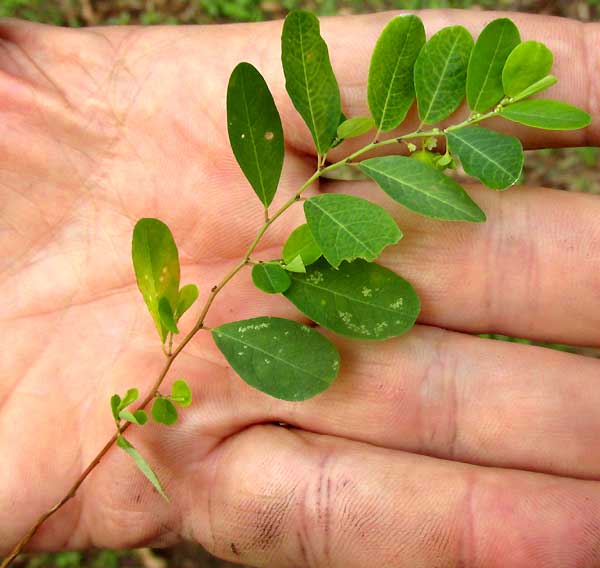
Above you can see an interesting little herb flowering in shaded disturbed areas here at the rancho. One interesting feature is that its slender stems are semi-woody at their bases. Another good field mark is shown below:
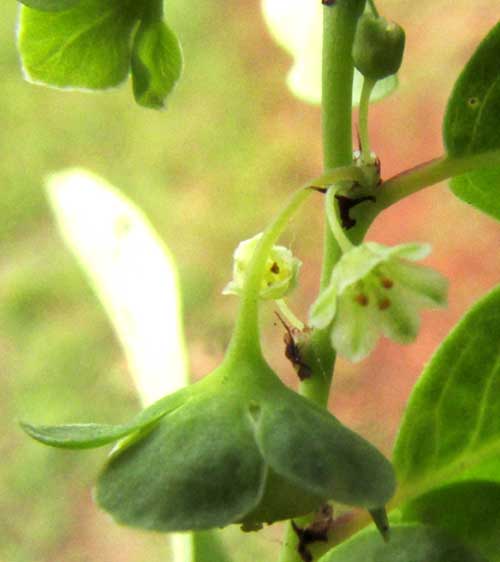
There you see two very different-looking flowers arising from the same leaf axil. The large, green flower dangling toward the picture's base is a unisexual female flower, while the smaller, white flower at right-center is a male flower. A shot of a female flower whose ovary has almost matured into a ripe fruit is shown below:

Two tiny male blossoms, each possessing three stamens, appear below:

Another interesting feature of the plant is its leaves' venation, which is unusually finely netted, or "reticulate," as shown below:
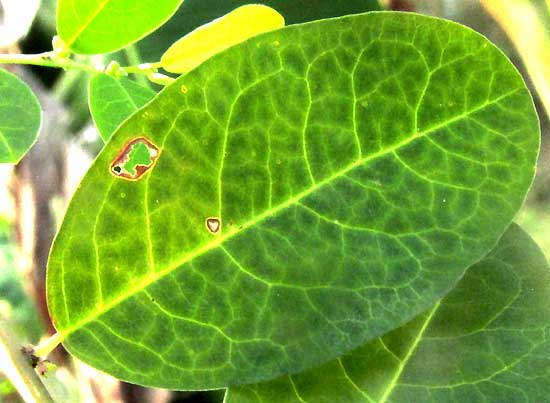
With the unisexual flowers and the fact that the plant's gross appearance suggests that of a spurge, or euphorbia, of the Spurge/Euphorbia Family, when I started thinking of that family I realized we'd seen similar species before, such as the Smartweed Leaf-flower, Phyllanthus polygonoides, met in 2013 in Texas. You might enjoy comparing our present plant with that one.
So, our rancho plant turned out to be another leaf-flower species, PHYLLANTHUS AMARUS, native from the southern US south through Mexico and Central America into South America. On the Internet many pages deal with the species because traditionally it has been much used medicinally, and now is grown and escaped in warm countries worldwide. It's species name amarus means "bitter," and medicines often are bitter, so it all makes sense.
In Jay Ram Patel's 2011 paper in the Journal of Ethnopharmacology, entitled "Phyllanthus amarus: Ethnomedicinal uses, phytochemistry and pharmacology: A review," it's said that in India's Ayurvedic system the species is important in the treatment of problems of the stomach, genitourinary system, liver, kidney and spleen. Also it's used for gonorrhea and other genital afflictions, as well as for diarrhea, dysentery, intermittent fevers, ophthalmopathy, scabies, ulcers and wounds.
There's every reason to believe that the plant may truly be medicinal. Patel's paper reports that laboratory analysis shows that the plant's extracts and compounds "...show a wide spectrum of pharmacological activities including antiviral, antibacterial, antiplasmodial, anti-inflammatory, antimalarial, antimicrobial, anticancer, antidiabetic, hypolipidemic, antioxidant, hepatoprotective nephroprprotective and diurectic properties."
from the January 18, 2019 Newsletter issued from Rancho Regensis north of Valladolid, Yucatán, MÉXICO;
elevation ~40m (~130 ft), N~20.876°, W~88.170°
JUAN'S TOOTHACHE, WEEK TWO
Last week I described how our Maya worker Juan came to work with his cheek swollen from a tooth-ache, the cheek plastered with pieces of medicinal herb. He called the commonly occurring herb Hool-k'iim. It was Talinum paniculatum, and its story with pictures appears on our Talinum paniculatum page at ../yucatan/talinum.htm
This week Juan got more serious about treating his pain by concocting a green paste made of three locally common herbs, and he was kind enough to let me document his various doings. His using three herbs instead of one sounds right to me because curanderos, or healers, I've known seldom relied on a single ingredient for their medicines. Their treatments usually consisted of three or more components.
First we went to the same place as before, to pick more Talinum paniculatum leaves. Then we walked just a few feet, to the other side of the shaded compost area, and picked a few leaves of Leaf-flower, Phyllanthus amarus, profiled above. Below, you can see Juan collecting his Leaf-flower leaves:

Notice that Juan isn't picking the whole plant, just removing leaves. The slender, wiry stem of Phyllanthus amarus is semi-woody, so Juan placed the stem between two fingers and raked upward, the leaves coming off individually. "Now the stem will grow new leaves," he said.
Next we gathered a few leaves of Square-stemmed Misteletoe, Phoradendron quadrangulare, parasitizing a nearby Bay Cedar, Guazuma ulmifolia. Our Square-stemmed Mistletoe page is at ../yucatan/mistlet3.htm
Below, you can see the entire collection of leaves from the three above species:
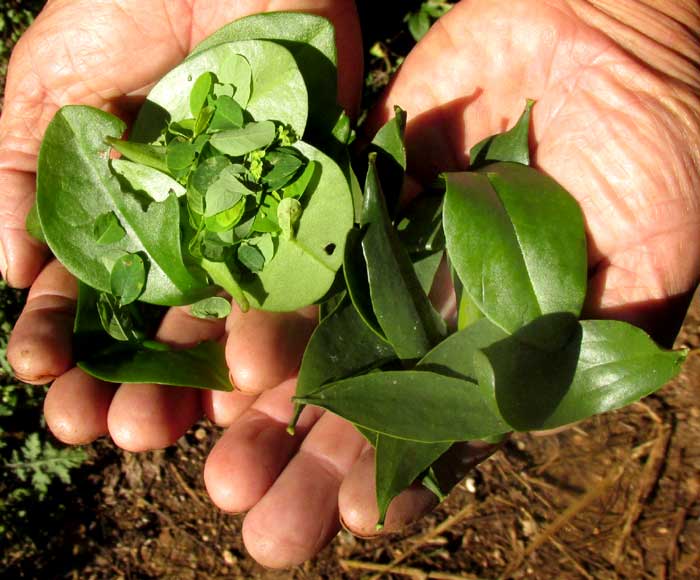
On the picture's left side, the larger leaves at the bottom are from Talinum paniculatum. Atop them lie the Leaf-flower's leaves, and on the right side of the picture you see the mistletoes's blades.
On our pages for the above plants we've already noted that these species are recognized widely as medicinal plants. Studies have shown that, in rats, extracts of roots and leaves of Talinum paniculatum produced "estrogenic activity... which can be helpful in managing reproductive tissues regression during menopause... " Extracts of the Square-stemmed Mistletoe affect "cytotoxicity, apoptosis, tumour inhibition, induction of immune processes and antioxidant activity." Leaf-flower is much used in India's Ayurvedic system of medicine for a long list of problems, including, gonorrhea and other genital afflictions, diarrhea, dysentery, intermittent fevers, ophthalmopathy, scabies, ulcers and general wounds."
Now it was time to mash the leaves into a green paste. Normally Juan uses as a grinding bowl, or morter, half of a gourd-like jícara fruit from what's sometimes called the Calabash Tree (Crescentia cujete. That interesting tree is profiled at ../yucatan/calabash.htm
However, Juan's jícara was filled with something else, so he used the bottom of a liter-size Coca-Cola plastic bottle, as shown below:
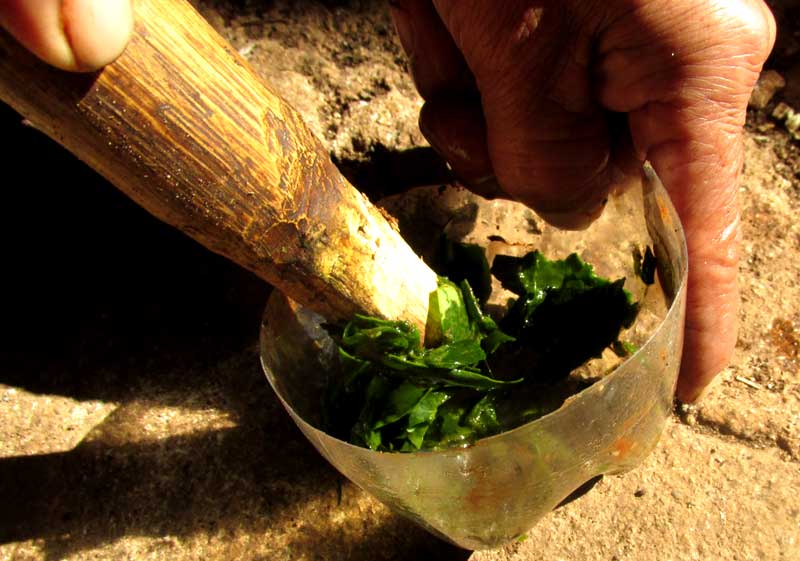
The grinder, or pestle, is just a solid piece of a young tree trunk quickly carved with a machete blade.